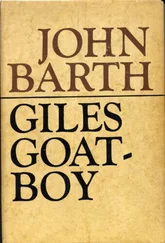The same went, needless to say, for the author of the novel — officially certified as a Master of Arts well before I had attained any mastery of the art I aspired to. Even in 1956, with two novels under my belt, I innocently presumed that since I had knocked them off in about six months each, this larger and very different project might take me as long as. . two years, maybe? In fact it took four, and my only subsequent venture into historical fiction, two decades later — a huge, intricate novel called LETTERS , having to do with our War of 1812—took seven years. Never again. It is one thing, I soon discovered, to decide to write a satirical 20th-century novel based on a satirical early-18th-century poem about colonial America, and quite another thing to learn enough about the facts of life back then to bring the thing off. In a comic novel, obviously — especially in a satirical farce — one has more license for anachronism than one would have in a straightforward historical novel or a period romance, such as those I cited before. I remember a conversation with William Styron back in 1965, in the course of which he mentioned to me that he was at work on a “straight” novel about Nat Turner’s Rebellion, and I asked him how he planned to avoid nit-picking from experts on period detail. His working strategy, Styron told me, was systematically to avoid such detail as far as possible and to concentrate instead on the characters’ psychology; my working strategy in Sot-Weed was to invoke the Muse of Comedy rather than her grim-faced sister.
All the same, it seemed important to me to acquire a fair degree of amateur expertise in three main areas — the history of the two colonies, the homely details of everyday life there (such as clothing, food and drink, and what the poet Gerard Manley Hopkins called “all trades, their gear and tackle and trim”), and the detailed flavor of the colonists’ written and spoken language, which also affords some access to their thoughts and feelings. If I perpetrated anachronisms of detail or language or psychology — and no doubt the novel has its share of those — I wanted them insofar as I could manage to be intentional anachronisms, not inadvertent ones. Even in satirical farce or fantasy, one ought not ignorantly to put carburetors on fuel-injected engines, for example, or have Charles Calvert call William Claiborne “Black Bill” if that nickname hadn’t yet come into use.
Back then I was living up in State College, Pennsylvania, on a meager assistant professor’s salary and had neither the funds nor the leisure (nor for that matter the temperament) to make research expeditions to St. Mary’s and Jamestown, Annapolis and Williamsburg. Other than such documents as Captain John Smith’s Generall Historie , William Byrd’s Secret Diary of the Dividing Line , and above all Ebenezer Cooke’s Sot-Weed Factor poem, my primary resource in this enterprise — and it turned out to be a splendid one — was the multivolume Archives of Maryland , which I discovered in the stacks of Penn State’s Pattee Library and immersed myself in for the next several years while drafting the novel. This formidable shelf of heavy folio volumes comprises mainly transcripts of the proceedings of the Governor’s Council and the General Assembly of the province from the time of its chartering up to the Revolution, but it also includes all sorts of depositions and complaints to the Provincial Court — an invaluable source for the names of everyday items, the kinds of hassles that folks were involved in, and the language they used to voice their grievances or defend their behavior. I wish I could give you pregnant examples, but at 40 years’ distance I have forgotten what frowes and inkles are, and suckets and pookes , and how many ells make a firkin , although those magical terms still sing in my memory. I do recall being impressed with differences between the English English of the late-17th/early-18th century and the English of the American colonials at that time. The language of Captain John Smith, both in his own writings and in the documents that I ghost-wrote for him (such as his Secret Historie of the Voiage up the Baie of Chesapeake ), has an Elizabethan flavor because Captain John was a bona fide Elizabethan; the language of Eben Cooke’s Sot-Weed Factor a hundred years later, and of Maryland Provincial Court depositions taken at the time of its writing, remains more Elizabethan than Georgian, no doubt for the same reason that one still hears occasional Elizabethanisms in the speech of Tangier and Smith Island waterfolk: isolation from the evolving mother tongue. A few critics of my novel picked linguistic-historical nits: The verb swive , for example, meaning “copulate,” which my characters employ with some frequency, is really more Chaucerian than early-18th-century, one such critic complained (“Thus swyvèd was that carpenteris wyf,” Chaucer remarks in “The Miller’s Tale”). True enough in merrie England, maybe, but we colonials were still a-swiving away and calling our pleasure by that name during the reigns of Queen Anne and George I. Call it cultural lag if you will; anachronism it is not. Thus swivèd was that particular book-reviewer, without his knowing it.
What else did I learn back then about everyday life hereabouts back then from my homework as a temporary amateur historian? What impressed me most, perhaps — and still does whenever my wife and I sail up the Potomac to St. Clements Island, where the Arke and the Dove first landed, or down-bay toward the James and Jamestown — is the dismaying fragility of those first English settlements, together with the formidable tenacity of the (surviving) settlers themselves: a tenacity in many cases born of desperation, to be sure, and of virtual lack of alternatives. Those little vessels and their meager provisions — meager even for those who could afford to bring with them the whole inventory recommended in Father Andrew White’s 1634 Relation of Maryland (which inventory he lifted almost verbatim from John Smith’s Generall Historie , and from which I lifted those aforementioned frowes and inkles and suckets and pookes) — so meager in the face of that green wilderness vaster by far than any of them could imagine, and their forsaken home so endlessly far behind! They were Robinson Crusoes, really, every one of them. We drop anchor and dinghy ashore; I try to imagine us landing not for a stroll and maybe a picnic and a swim, but for keeps , with fall and winter coming on, and the natives not necessarily delighted to see us laying claim to their turf, and everything to be done from scratch: shelters and defenses to be built, forests to be cleared and crops planted and clothing made and mended, teeth pulled and broken bones set and bread baked and babies delivered, not to mention courts and legislatures and such to be established….
I shake my head. A catastrophe-in-the-making it undeniably was for the indigenous peoples and their cultures, this literal and figurative European infection; it was arguably a disaster-in-the-making for the natural environment, too — yet what a testament all the same to the intrepidity of those men and women! A flick of the fingers, one can’t help feeling, would have been enough to push the whole fledgling operation back into the sea, for better or worse depending on your perspective; yet not only did the surviving new arrivals hang in there and quickly begin their fateful outspreading through the territory, but in no time at all they were hassling each other with their left hands while scratching out niches for themselves in the wilderness with their right: Marylanders versus Virginians, papists versus antipapists, neighbors versus neighbors, while rumors abounded that the French and the Indians, or the Jesuits and who have you, were conspiring up-country to sweep down and massacre all hands.
Читать дальше












